EDITORIAL
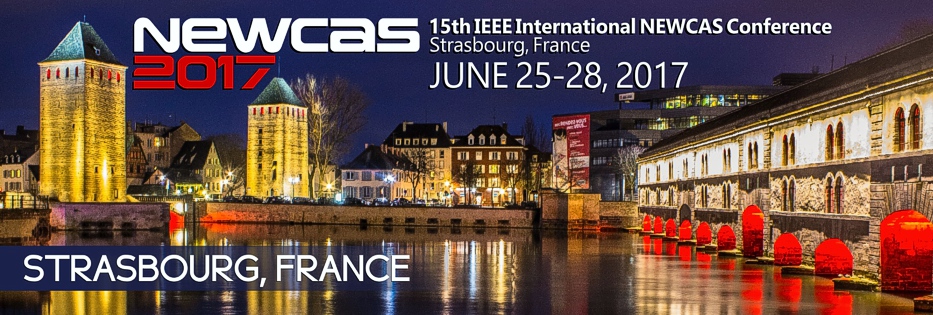 The 15th edition of the IEEE International NEWCAS Conference that was held from June 25 to 28 in Strasbourg, France, was organised by Professor Luc Hébrard’s team of the Université de Strasbourg joined by some members of ReSMiQ. Launched in 2003 in Montreal, under the sponsorship of the IEEE Circuits and Systems society (CAS), it has progressively grown to become a major meeting event and is now a full-fledged IEEE conference. This world-class conference has been hosted for the fifth time across the Atlantic in France after Grenoble (2015), Paris (2013), Bordeaux (2011) and Toulouse (2009). It is worth noting that the acceptance rate of 47.5% allowed the conference to achieve a remarkable level of quality. The spectrum of research topics covered this year attracted 191 submissions from over 30 countries. These were sorted and evaluated by the members of the technical committee and external reviewers who conducted in-depth evaluation of each paper. The final selection resulted in the presentation of 73 articles in lecture sessions and 29 in poster sessions. It was also a great honor to welcome world renowned speakers who shared their knowledge and their expertise with the attendees such as Edoardo Charbon, of the École polytechnique fédérale de Lausanne, Nando Basile, of X-FAB and co-founder of Spike 3D Concept engineering, and Pantelis Georgiou, of the Imperial College in London. We congratulate all the members of the organizing committee for this success and we also take this opportunity to thank the sponsors for their support. It is in this spirit that we look forward to seeing you next year in Montréal from June 24 to 27 of 2018.
The 15th edition of the IEEE International NEWCAS Conference that was held from June 25 to 28 in Strasbourg, France, was organised by Professor Luc Hébrard’s team of the Université de Strasbourg joined by some members of ReSMiQ. Launched in 2003 in Montreal, under the sponsorship of the IEEE Circuits and Systems society (CAS), it has progressively grown to become a major meeting event and is now a full-fledged IEEE conference. This world-class conference has been hosted for the fifth time across the Atlantic in France after Grenoble (2015), Paris (2013), Bordeaux (2011) and Toulouse (2009). It is worth noting that the acceptance rate of 47.5% allowed the conference to achieve a remarkable level of quality. The spectrum of research topics covered this year attracted 191 submissions from over 30 countries. These were sorted and evaluated by the members of the technical committee and external reviewers who conducted in-depth evaluation of each paper. The final selection resulted in the presentation of 73 articles in lecture sessions and 29 in poster sessions. It was also a great honor to welcome world renowned speakers who shared their knowledge and their expertise with the attendees such as Edoardo Charbon, of the École polytechnique fédérale de Lausanne, Nando Basile, of X-FAB and co-founder of Spike 3D Concept engineering, and Pantelis Georgiou, of the Imperial College in London. We congratulate all the members of the organizing committee for this success and we also take this opportunity to thank the sponsors for their support. It is in this spirit that we look forward to seeing you next year in Montréal from June 24 to 27 of 2018.
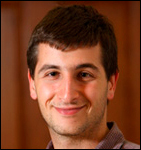
We are pleased to announce that ReSMiQ has a new member, professor Paul-Vahé Cicek of the department of computer science at Université du Québec à Montréal. He works in the field of convergent integration of microtechnologies.
ReSMiQ is a group of researchers in an interuniversity research center that can count on the support of the Fonds de recherche du Québec – Nature et technologies (FRQNT) and nine (9) Quebec universities involved in microsystems research.
NEWS FROM OUR MEMBERS
Achievement
– Dr. Gosselin from Université Laval is part of a team who was awarded the prize for best technical demonstration for a robotic arm at the IEEE ISCAS2017 held in Baltimore, United States.
More details / Demonstration video
– Dr. Fontaine from the Université de Sherbrooke is supervising Jonathan Bouchard at the Ph.D. who is the recipient of a Vanier scholarship for the project entitled Conception d’un scanner de tomographie d’émission par positrons. More details
RESMIQ’S ACTIVITIES
 Date: October 12, 2017
Date: October 12, 2017
Venue: Polytechnique Montréal
— UPCOMING —
Scholarships and financial support for graduate students
ReSMiQ Scholarship and supplementary scholarship
APPLICATION DEADLINE: August 16, 2017
More details
Scholarship for post-doctoral fellow
APPLICATION DEADLINE: August 16, 2017
More details
6th microsystems experimental demonstration competition
University undergraduate and graduate students and students from college/CEGEP of the province of Québec are invited to participate in the next competition of the 6th edition of the ReSMiQ innovation day by submitting their project. More than 5000$ in prizes!
SUBMISSION DEADLINE: September 11, 2017
More details
SIGNAL is the main monthly information medium of the Microsystems Strategic Alliance of Québec (ReSMiQ). This newsletter aims to be an active link between the members of ReSMiQ and all individuals who have an interest in research and innovation in microsystems. We commit ourselves to promote in it our members’ research and increase ReSMiQ’s visibility.
ReSMiQ is a group of researchers in an interuniversity research center that can count on the support of the Fonds de recherche du Québec – Nature et technologies (FRQNT) and nine (9) Quebec universities involved in microsystems research.



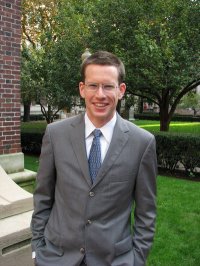 Glenn Cowan received the Ph.D. degree in Electrical Engineering from Columbia University, New York, USA. He is currently an Associate Professor in the VLSI research group in the Department of Electrical and Computer Engineering at Concordia University, Montreal, Canada. He worked in the Communications Technology Department at the IBM T. J. Watson Research Center, NY, where his research activities included CMOS circuits for high-speed communications, design for manufacturability, and circuits for the measurement of process variability. His current research interests are in low-power mixed-signal circuits for wireless, wireline, and optical communication, as well as mixed-signal computation. Dr. Cowan has published several refereed papers in journals and international conferences and holds 1 patents.
Glenn Cowan received the Ph.D. degree in Electrical Engineering from Columbia University, New York, USA. He is currently an Associate Professor in the VLSI research group in the Department of Electrical and Computer Engineering at Concordia University, Montreal, Canada. He worked in the Communications Technology Department at the IBM T. J. Watson Research Center, NY, where his research activities included CMOS circuits for high-speed communications, design for manufacturability, and circuits for the measurement of process variability. His current research interests are in low-power mixed-signal circuits for wireless, wireline, and optical communication, as well as mixed-signal computation. Dr. Cowan has published several refereed papers in journals and international conferences and holds 1 patents. 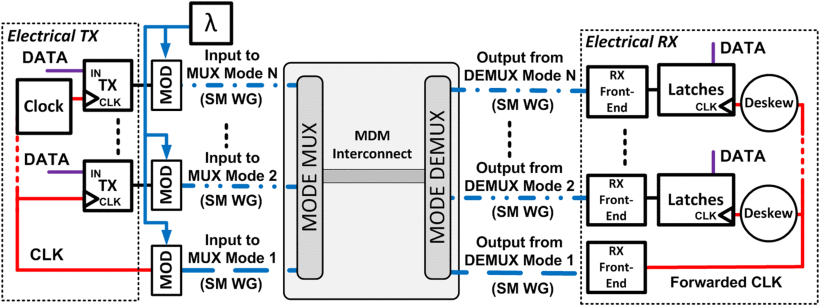
 Fig. 2. Microscope images of the SiP 750 μm optical interconnect. Distance between grating couplers (127 μm) given for scale.
Fig. 2. Microscope images of the SiP 750 μm optical interconnect. Distance between grating couplers (127 μm) given for scale.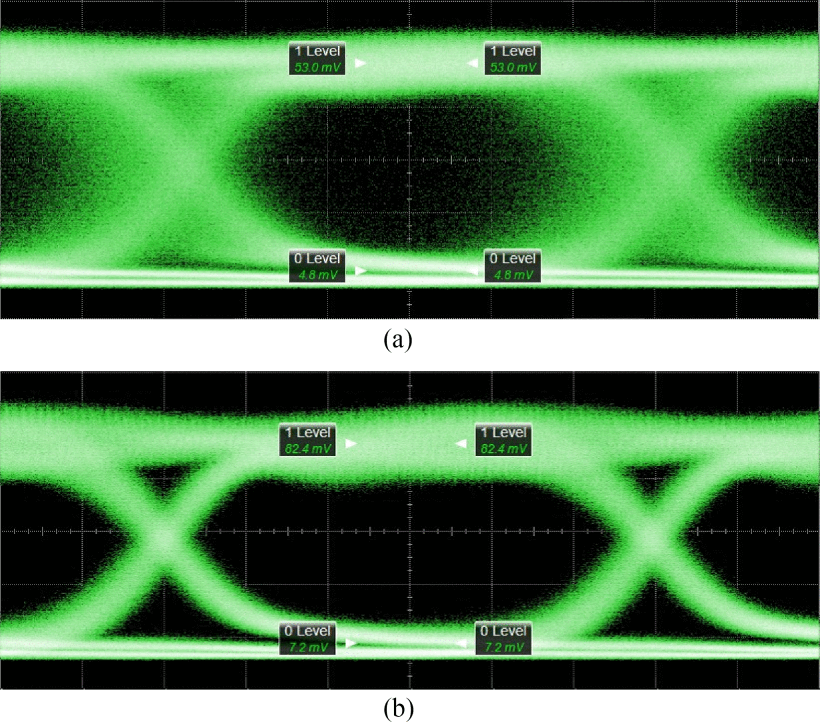 Fig. 3. Electrical eye diagrams of data transmission at 1553 nm captured with oscilloscope triggered by the forwarded (a) optical clock on mode 2 and (b) electrical clock bypassing the DUT. As observed, the method of sending the clock notably changes the eye. Closure of the eye horizontally is caused by modal crosstalk induced jitter.
Fig. 3. Electrical eye diagrams of data transmission at 1553 nm captured with oscilloscope triggered by the forwarded (a) optical clock on mode 2 and (b) electrical clock bypassing the DUT. As observed, the method of sending the clock notably changes the eye. Closure of the eye horizontally is caused by modal crosstalk induced jitter.